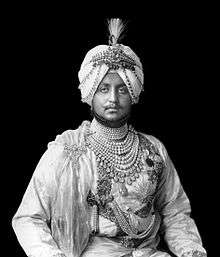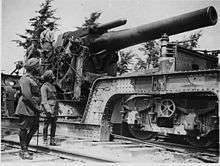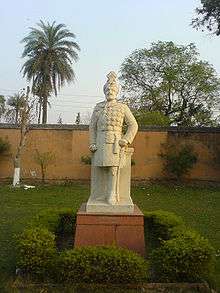Bhupinder Singh of Patiala
| Bhupinder Singh | |
|---|---|
| Maharaja of Patiala | |
 Bhupinder Singh in 1911 | |
| Maharaja of Patiala | |
| Reign | 8 November 1900 - 23 March 1938 |
| Predecessor | Maharaja Rajinder Singh I |
| Successor | Maharaja Yadavindra Singh I |
| Minister of State |
See list
|
| Born |
12 October 1891 Moti Bagh Palace, Patiala |
| Died |
23 March 1938 (aged 46) Patiala |
| Dynasty | Phulkian |
| Father | Maharaja Rajinder Singh I of Patiala |
| Mother | Jasmer Kaur |
| Religion | Sikhism |
Maharaja Sir Bhupinder Singh GCSI GCIE GCVO GBE (Punjabi: ਭੁਪਿੰਦਰ ਸਿੰਘ; 12 October 1891 – 23 March 1938) was the ruling Maharaja of the princely state of Patiala from 1900 to 1938.[1]
Biography
Bhupinder Singh was born at the Moti Bagh Palace, Patiala[2] and educated at Aitchison College. At age 9, he succeeded as maharaja of Patiala state upon death of his father, Maharaja Rajinder Singh, on 9 November 1900. A Council of Regency ruled in his name until he took partial powers shortly before his 18th birthday on 1 October 1909 and was invested with full powers by the Viceroy of India, the 4th Earl of Minto, on 3 November 1910.

He served on the General Staff in France, Belgium, Italy and Palestine in the First World War as an Honorary Lieutenant-Colonel, and was promoted Honorary Major-General in 1918 and Honorary Lieutenant-General in 1931. He represented India at the League of Nations in 1925, and was chancellor of the Indian Chamber of Princes for 10 years between 1926 and 1938, also being a representative at the Round Table Conference. He married many times and had many children by his wives and concubines.
Maharaja Bhupinder Singh was the first man in India to own an aircraft, which he bought from the United Kingdom in the first decade of the twentieth century. For his aircraft he had an airstrip at Patiala built.
He was well known for the construction of buildings with bold architectural designs in Patiala, including Kali Temple, Patiala, and Chail View Palace in the summer retreat of Kandaghat along with Chail Palace and Oak Over and Cedar Lodge in Shimla which now houses the Chief Minister of Himachal Pradesh and Punjab State Guest House respectively.[3] He was known as a sportsman and built the world's highest cricket pitch at 2443 m in 1893 at Chail. He was also known for an exceptional collection of medals, believed to be the world's largest at the time.[4] According to legend, Maharaja Bhupinder Singh would be driven in a motorcade of 20 Rolls Royce cars. He had a unique monorail system built in Patiala known as Patiala State Monorail Trainways.
His then Education Minister, Pt. Makhan Lal Banerjee accompanied him to the summer capital of Chail and was also a well-known referee in cricket.
He is perhaps the most famous Maharaja of Patiala, best known for his extravagance and for being a cricketer. His cricket and polo teams – Patiala XI and Patiala Tigers – were among the best of India. He was a great patron of sports.
He was captain of the Indian cricket team that visited England in 1911 and played in 27 first-class cricket matches between 1915 and 1937.[5] For season of 1926/27, he played as member of Marylebone Cricket Club . He donated the Ranji Trophy in honour of Kumar Shri Ranjitsinhji, Jam Sahib of Nawanagar. He was selected as the captain of India on its first Test tour of England in 1932, but dropped out for reasons of health two weeks before departure and the Maharaja of Porbandar took over. The cricket ground at Chail was made by Maharaja Patiala in 1893. It is the highest cricket ground in the world. Most of the buildings of Chail Military School were donated by Maharaja of Patiala to the government of India.
Sir Bhupinder Singh founded the State Bank of Patiala in 1917.
He served as the Chancellor of Chamber of Princes from 1926 to 1931. He worked tirelessly for his subjects' betterment and introduced many social reforms in Patiala.
His elder son, Maharaja Yadavindra Singh and younger son Raja Bhalindra Singh both played first-class cricket, Yuvraj also played in one Test for India, in 1934. Raja Bhalindra Singh, later served as President of Indian Olympic Association.
Yuvraj Yadavindra Singh became the Maharaja on 23 March 1938. He was to be the first Maharaja, agreeing to the incorporation of Patiala into the newly independent India on 5 May 1948, becoming Rajpramukh of the new Indian state of Patiala and East Punjab States Union.
Bhupinder Singh's grandson Captain Amarinder Singh is a politician in India and served as Chief Minister of Punjab from 2002 to 2007. Captain Amarinder was again elected as Chief Minister of Punjab (India) in 2017.
Personal life
Bhupinder Singh married five times and had numerous consorts. From those unions, he sired an estimated 88 children of whom at least 53 survived him. He was the proud owner of the world-famous "Patiala Necklace" manufactured by the famous brand Cartier SA. His wife Maharani Bakhtawar Kaur presented Queen Mary with a magnificent necklace on behalf of the Ladies of India during the Delhi Durbar of 1911 to mark the first visit to India by any Queen Empress.[6]
On 23 March 1938 Bhupinder Singh died.
Wives and consorts
Of his five wives, Maharani Vimala Kaur Sahiba of Patiala (1906 - 1992), his 3rd Dowager Maharani from Ubbewal was his favorite wife. She attended all the ceremonies with him and travelled abroad.
Titles
- 1891–1900: Sri Yuvaraja Sahib Bhupinder Singhji
- 1900–1911: His Highness Farzand-i-Khas-i-Daulat-i-Inglishia, Mansur-i-Zaman, Amir ul-Umara, Maharajadhiraja Raj Rajeshwar, 108 Sri Maharaja-i-Rajgan, Maharaja Bhupinder Singh, Mahendra Bahadur, Yadu Vansha Vatans Bhatti Kul Bushan, Maharaja of Patiala
- 1911–1914: His Highness Farzand-i-Khas-i-Daulat-i-Inglishia, Mansur-i-Zaman, Amir ul-Umara, Maharajadhiraja Raj Rajeshwar, 108 Sri Maharaja-i-Rajgan, Maharaja Sir Bhupinder Singh, Mahendra Bahadur, Yadu Vansha Vatans Bhatti Kul Bushan, Maharaja of Patiala, GCIE
- 1914–1918: Lieutenant-Colonel His Highness Farzand-i-Khas-i-Daulat-i-Inglishia, Mansur-i-Zaman, Amir ul-Umara, Maharajadhiraja Raj Rajeshwar, 108 Sri Maharaja-i-Rajgan, Maharaja Sir Bhupinder Singh, Mahendra Bahadur, Yadu Vansha Vatans Bhatti Kul Bushan, Maharaja of Patiala, GCIE
- 1918–1921: Major-General His Highness Farzand-i-Khas-i-Daulat-i-Inglishia, Mansur-i-Zaman, Amir ul-Umara, Maharajadhiraja Raj Rajeshwar, 108 Sri Maharaja-i-Rajgan, Maharaja Sir Bhupinder Singh, Mahendra Bahadur, Yadu Vansha Vatans Bhatti Kul Bushan, Maharaja of Patiala, GCIE, GBE
- 1921–1922: Major-General His Highness Farzand-i-Khas-i-Daulat-i-Inglishia, Mansur-i-Zaman, Amir ul-Umara, Maharajadhiraja Raj Rajeshwar, 108 Sri Maharaja-i-Rajgan, Maharaja Sir Bhupinder Singh, Mahendra Bahadur, Yadu Vansha Vatans Bhatti Kul Bushan, Maharaja of Patiala, GCSI, GCIE, GBE
- 1922–1931: Major-General His Highness Farzand-i-Khas-i-Daulat-i-Inglishia, Mansur-i-Zaman, Amir ul-Umara, Maharajadhiraja Raj Rajeshwar, 108 Sri Maharaja-i-Rajgan, Maharaja Sir Bhupinder Singh, Mahendra Bahadur, Yadu Vansha Vatans Bhatti Kul Bushan, Maharaja of Patiala, GCSI, GCIE, GCVO, GBE
- 1931–1935: Lieutenant-General His Highness Farzand-i-Khas-i-Daulat-i-Inglishia, Mansur-i-Zaman, Amir ul-Umara, Maharajadhiraja Raj Rajeshwar, 108 Sri Maharaja-i-Rajgan, Maharaja Sir Bhupinder Singh, Mahendra Bahadur, Yadu Vansha Vatans Bhatti Kul Bushan, Maharaja of Patiala, GCSI, GCIE, GCVO, GBE
- 1935–1938: Lieutenant-General His Highness Farzand-i-Khas-i-Daulat-i-Inglishia, Mansur-i-Zaman, Amir ul-Umara, Maharajadhiraja Raj Rajeshwar, 108 Sri Maharaja-i-Rajgan, Maharaja Sir Bhupinder Singh, Mahendra Bahadur, Yadu Vansha Vatans Bhatti Kul Bushan, Maharaja of Patiala, GCSI, GCIE, GCVO, GBE, GCSG
Honors

(ribbon bar, as it would look today)
![]()
![]()
![]()
![]()
![]()
![]()
![]()
![]()
![]()
![]()
![]()
![]()
![]()
![]()
![]()
![]()
![]()
![]()
![]()
![]()
![]()
![]()
![]()
British
- Delhi Durbar Gold Medal – 1903
- Delhi Durbar Gold Medal – 1911
- King George V Coronation Medal – 1911
- Knight Grand Commander of the Order of the Indian Empire (GCIE) – 1911
- 1914 Star
- British War Medal – 1918
- Victory Medal – 1918
- Mentioned in Despatches – 1919
- Knight Grand Cross of the Order of the British Empire (GBE) – 1918
- Knight Grand Commander of the Order of the Star of India (GCSI) – for war services, New Year Honours 1921[8]
- Knight Grand Cross of the Royal Victorian Order (GCVO) – 1922
- King George V Silver Jubilee Medal – 1935
- King George VI Coronation Medal – 1937
Foreign
- Grand Cross of the Order of the Crown of Italy – 1918
- Grand Cordon of the Order of the Nile of Egypt – 1918
- Grand Cordon of the Order of Leopold of Belgium – 1918
- Grand Cross of the Order of the Crown of Romania – 1922
- Grand Cross of the Order of the Redeemer of Greece – 1926
- Grand Cross of the Order of Charles III of Spain – 1928
- Grand Cross of the Order of the White Lion of Czechoslovakia – 1930
- Grand Cross of the Legion d'Honneur of France – 1930 (Grand Officer – 1918)
- Grand Cross of the Order of Saints Maurice and Lazarus of Italy – 1935
- Grand Cross of the Order of St Gregory the Great of the Vatican – 1935
- Grand Cross of the Order of Dannebrog of Denmark
Other
- A Unani College, namely 'Bhupinder Tibbi College' was after his name at Patiala
Footnotes
- ↑ History of Patiala from Patiala web site
- ↑ "Historical Sikh Events: Phulkian Misl".
- ↑ Himachal Pradesh – Solan website Archived 29 September 2007 at the Wayback Machine.
- ↑ Singh J. A medal for collecting medals. The Tribune (Chandigarh) Sunday, 29 February 2004
- ↑ "Royalty on the cricket field". International Cricket Council. Retrieved 18 May 2018.
- ↑ "Emerald and diamond choker". Royal Collection. Although, he was married five (5) times, his favorite wife was his third Wife, Maharani Vimal Kaur Sahiba of Ubbewal
- ↑ Patiala
- ↑ "No. 32178". The London Gazette (Supplement). 1 January 1921. p. 5.
External links
| Wikimedia Commons has media related to Bhupendra Singh Patiala. |
- Cricketarchive profile of Bhupinder Singh
- The Maharja's Travel to Vienna, Austria
- Maharaja of Patiala
- Bhupinder Singh, Maharaja of Patiala
- Genealogy of the rulers of Patiala
- Article in Tribune on the Myth of Bhupinder's role in building Chail
Bhupinder Singh of Patiala Born: 12 October 1891 Died: 23 March 1938 | ||
| Regnal titles | ||
|---|---|---|
| Preceded by Rajinder Singh |
Maharaja of Patiala 1900–1938 |
Succeeded by Yadavindra Singh |